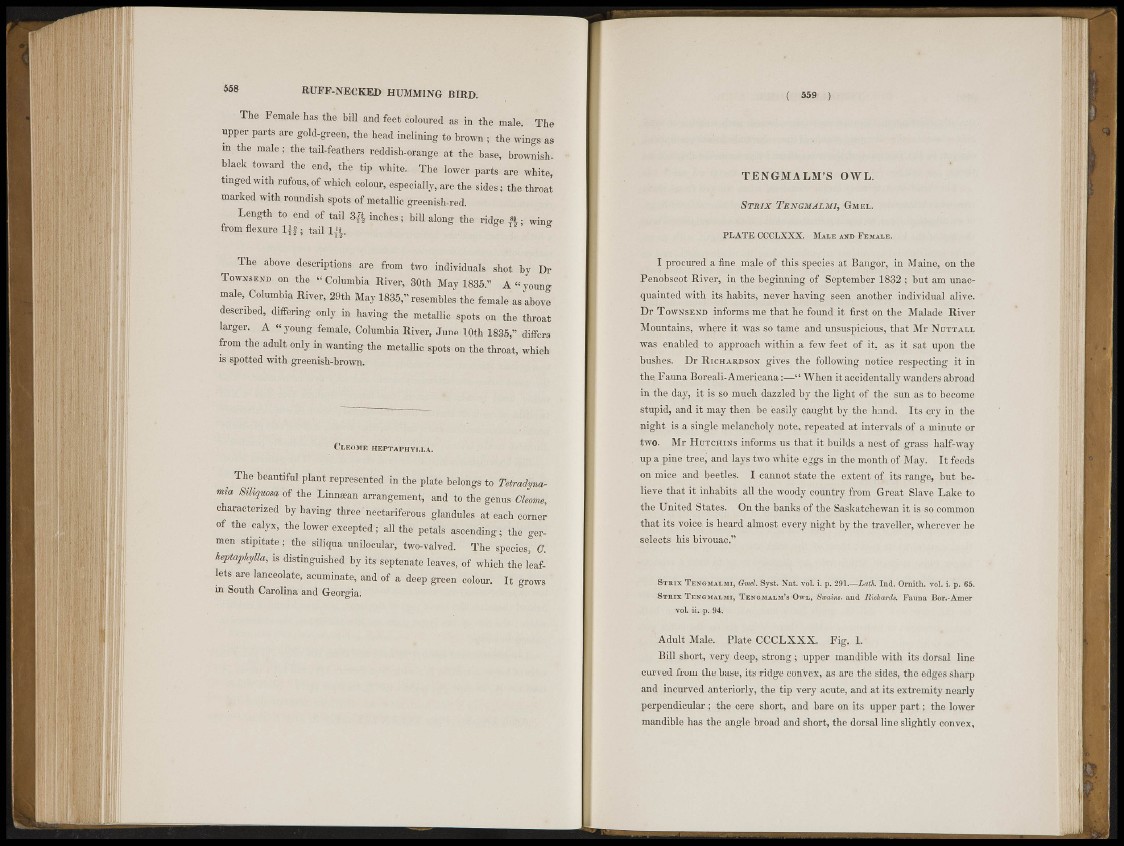
5 5 8 FTUFF-NHT'KED HU M M I N G BIRD.
• The Female ha* the bill ami feet coloured as in thé male. The
upper parts are gold-greèn, the head mdinmg-fo brown: ; the A g , as
m the male; the tail-feathers reddish-orange at the.bas», brownish
black toward the U.vver parts are white,
tanged with rufous, of which colour, . ^ c i a l l y , are the si te«: the throat
marked with rmmdish spots of metallic greenish-red.
Length to end "f tail ffl inches; bill along the ridge A • wins
froin flexure
The abqye descriptions aie from two indiwduàls: shot, by I)r
'IWsKNi, «a the "Columbia Ewer, 3Qth May 1835." & -youpg
male, (¡lumhia River, 29th May 16.36," resembles the female as above
described, differing only: in having the metallic spots on the throat
larger. A "young femalei Columbia Hiver; June 10th 1835," differs
from the adult only in wanting the metallic spotsvon the throat, which)
is spotted with greenisih-brown.
CLÈOME HEPTAPHYR.LA.
The beautiful plant represented in the plate belongs to THradtmamia
SiKqmsa oi the Einmean arrangement, aad to'tfe genus Glkme;
characterised by having three'nectariferous glandulei-at each Corner
of the calyx, the lower escei.^»; all the petals ascending; the germen
stipitate ; the silkpia unilocular, two-valved! The spte'/V.
hqdaphvlla, is distinguished by its sept.-nate loaves, of which the leaf-'
lets are.lanceolate, acuminate, and of a deep green colour. It grows
in South Carolina and Georgia:
(• 55» J
T E N G M A L M ' S OWL.
STRIX TENGMALMI, GM E L .
P L A T E CA.X-L.XXX. MAI.F. ASI) I'KMAI.»:.
I procured a fine, male of this species at Bangor, in Maine, on the
Penobscot River, in the beginning of September 1832 ; but am unacquainted
with its habits, never having seen another individual alive.
Dr TOWNSEND iBrms me that he found it first on the Malade River
Mountains, where IT was so; tame and unsuspicious, that Mr NUTTAU.
was cmabled to approach within a few feet of it, as it sat upon the
bushes. Dr KIOHARDSOX gives the: following notice respecting it in
the. Faun» BoreaH-Americana :•—'1 When it accidentally wanders abroad
in the da£j. | t is so much dazzled by the light of the sun as to become
stupid; and it may then be easily caught by the hand. Its cry in the
night is a single melancholy note, repeated at intervals of a minute or
two. Mr HOTCHIMS informs us that it builds a nest of grass half-way
up a pigo tree, and lays two white e|gg in the month of May. It feeds
on mice and beetliis I cannot state the extent of its range, but halieve
that it inhabits all the w«!>dy country from Great Slave Lake to
the United States. On :th§. banks of the Saskatchewan it is so common
that its voice, is heard .almost every n§8ht by the traveller, wherever lie
selects: his bivouac."
STRIX TENGMAI.MI, G-md. Syst. Nat . vol. i. p. 291.—Lath. Ind. Ornitli. vol. i. p . 68.
STRIX TENGMAI.MT, TENGMAEM'SOWIJ, Swains, and Richards. Fauna Bor.-Amer
vol. ii. p. 91.
Adult Male,, I'late OCCLXXX.. -Fig. 1.
Bill short, xery deep, strong,; mpper mandible with its dorsal line
curved fr om the base, its ridge .convex,, as are the sides, the edges sharp
and incurved anteriorly, the tip very acute, and at its extremity nearly
perpendicular.; the cepe short, and bare on its upper par t ; the lower
mandible has the angle broad and short, the dorsal line slightly convex,